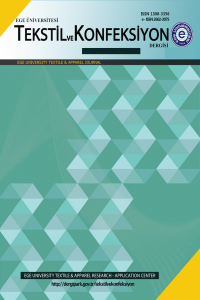Poisson’s Ratio of Non-Woven Spun Bonded Fabric for Medical Apparel
Poisson’s Ratio of Non-Woven Spun Bonded Fabric for Medical Apparel
Anisotropy, Flexural rigidity, Non-woven Poisson's ratio, Uni-axial test,
___
- Greaves G N, Greer A L, Lakes R S and Rouxel T.2011. Poisson’s ratio and modern materials, Nature Materials, Vol 10, Doi: 10.1038/NMAT3134, 823-837
- Tadeja Penko & Jelka Gersak. 2016. Strip Quadratic method for determining the Poisson’s ratio of woven fabrics, Textile Research Journal, Vol 86(I) 86-96.
- Lloyd D W & Hearle J W S. 1977. An Examination of a ‘Wide-jaw’ test for the determination of fabric Poisson ratios, Journal of Textile Institute, No.9 299-302.
- Kilby WF. 1963. Planar stress-strain relationship in woven fabrics, Journal of Textile Institute, 54 1: T9-T27.
- Bao L, Takatera M, Shinohara A.1997.Error evaluation in measuring the apparent Poisson’s ratios of textile fabrics by uni-axial tensile test, Sen’i Gakkaishi 53 2: 20-26.
- Bao L, Takatera M, Shinohara A, et al.1997. Determining the apparent shear rigidity of textile fabrics by uni-axial tensile test, Sen’i Gakkaishi 53 4:139-145.
- Bassett RJ, Postle R, Pan N. 1999. Methods for measuring fabric mechanical properties, A review and analysis, Textile Research Journal, 69 11: 866-875.
- Ezaz Shahabi N, Siamak Saharkhiz, Hosseini Varkiyani S M. 2013. Effect of fabric structure and weft density on the Poissons’s ratio of worsted fabric, Journal of Engineered Fibres and Fabrics, Volume 8 Issue 2.
- Ezaz Shahabi N, Hosseini Varkiyani S M. January 2020. A Review on the Poisson’s ratio of fabrics, Journal of Textiles and Polymers, Vol. 8 No.1.
- Sun H, Pan N & Postle R. 2005. On the Poisson’s ratios of a Woven Fabric, Composite Structures Vol 68 Issue 4 505-510.
- Hearle J W S & Ozsanlav V. 1979. Studies of Adhesive-Bonded Non-Woven fabrics, Part II: The determination of various parameters for stress predictions, Journal of Textile Institute, No. 10.
- Hursa A, Rolich T. &.Ercegovic Razic S.2009. Determining Pseudo Poisson’s ratio of woven fabric with digital image correlation method, Textile Research Journal, Sep 18.
- Bhuvenesh C. Goswami , Jogendra Suryadevara & Tyrone L. Vigo, Determination of Poisson’s ratio in thermally bonded Non-woven fabrics, Textile Research Journal, 54(6) 391-396.
- Snjezana Brnada, Zeljko Somodi & Stana Kovacevic. May 2019. A new method for determination of Poisson’s ratio of Woven fabric at higher stresses, Journal of Engineered Fibres and Fabrics.
- Zeljko Penava, Diana Simic Penava & Zeljko Knezic. 2014. Determination of the Elastic Constants of Plain Woven Fabrics by a tensile test in Various Directions, FTEE, Vol 22 No 2(104) 57-63.
- Giroud J P.2004. Poisson’s ratio of unreinforced geo-membranes and non-woven geo-textiles subjected to large strains, Geotextiles and membrane, 297-305.
- Collier J R., Sargand S M, Gina O Toole. 1991. Drap e prediction by means of finite-element analysis, Journal of Textile Institute, 82(1) 96-107.
- Jinyun Z. 1965-1969. The Poisson Ratio and Modulus of Elastic Knitted Fabrics, Textile Research Journal, Vol 80(18).
- Leucker K & Schubert.Dirk W. 2019. Analysis and Modeling of the influence of the size and fraction of bonding points onto the mechanical behavior of polypropylene spun-bond non-wovens, Journal of Advance Engineering Materials, 1900769 (1-7) DOI: 10.1002/adem.201900769.
- Leaf G A V.2001. Analytical plain weave fabric mechanics and estimation of initial shear modulus, Journal of Textile Institute, vol.92 no. 3 70-79.
- Zhang G H, Ghita O, Evans KE. 2015. The fabrication and mechanical properties of a novel 3- component auxetic structure for composites. Composites Science and Technology, 117: 257–267. https://doi.org/10.1016/j.compscitech.2015.06.012
- Miller W, Hook P B, Smith CW, et al. 2009. The manufacture and characterisation of a novel, low modulus, negative Poisson’s ratio composite. Composite Science and Technology, 69: 651–655. https://doi.org/10.1016/j.compscitech.2008.12.016
- Sloan M R, Wright J R, Evans K E. 2011. The helical auxetic yarn - A novel structure for composites and textiles; Geometry, manufacture and mechanical properties. Mechanics of Materials, 43: 476–486. https://doi.org/10.1016/j.mechmat.2011.05.003
- Ali M, Zeeshan M, Ahmed S. 2018. Development and Comfort Characterization of 2D-Woven Auxetic Fabric for Wearable and Medical Textile Applications. Clothing and Textile Research Journal, 36: 199–214. https://doi.org/10.1177%2F0887302X18768048
- Tiritoğlu M, Tezel S, Kavuşturan Y. 2021. Comparison of Poisson’s ratio Measurement Methods: The Extensometer and the Universal Tensile Testing Devices, Textile and Apparel, 31(3): 203-213. https://doi.org/10.32710/tekstilvekonfeksiyon.895876
- Chen B and Govindaraj M, 27. 1996. A Parametric Study of Fabric Drape. Textile Research Journal 66 (1) 24-29.
- Penava Z, Simic D, Knezic. 2017. Influence Kinds of Materials on the Poisson’s ratio of Woven Fabrics. Tehnicki Glasnik 11, 3(2017), 101-106
- Rawal A. 2010. Bending Rigidity of Thermally Bonded Nonwoven Structures, Fibers and Polymers, Vol.11, No.4, 654-660, DOI 10.1007/s12221-010-0654-1
- Yilmaz K B, Sabuncuoglu B, Yildirim B and Silberschmidt V.2020. A brief review on the mechanical behavior of nonwoven fabrics, Journal of Engineered Fibers and Fabrics, Volume 15: 1–9 , DOI: 10.1177/1558925020970197
- ISSN: 1300-3356
- Yayın Aralığı: Yılda 4 Sayı
- Başlangıç: 1991
- Yayıncı: Ege Üniversitesi
Ece KALKANLI TURAN, Belkıs ZERVENT ÜNAL
Poisson’s Ratio of Non-Woven Spun Bonded Fabric for Medical Apparel
Dr.pasupathy RAMAMURTHY, Suganthi PARANTHAMAN
Nazife KORKMAZ MEMİŞ, Sibel KAPLAN
Imidazolium and Ammonium-Based Ionic Liquids for Reactive Dyeing
Havva Nur ÖZDEMİR, Gülşah Ekin KARTAL, Özgür Yasin KESKİN, Yasemin SEKİ
Investigation on Thermal Comfort Characteristics of Newly Engineered Yarn Umorfil® Knitted Fabrics
Comfort Properties of Functional Double Bed Knitted Fabric for Firefighters Underwear
živa ZUPİN, Karmen KNİFİC, Alenka PAVKO ČUDEN
Analyzing Efficiency and Productivity Changes of Turkish Textile Firms
Başak APAYDIN AVŞAR, Önder BELGİN
Effect of Sewing Thread Properties on Seam Performance of Woven Fabrics
